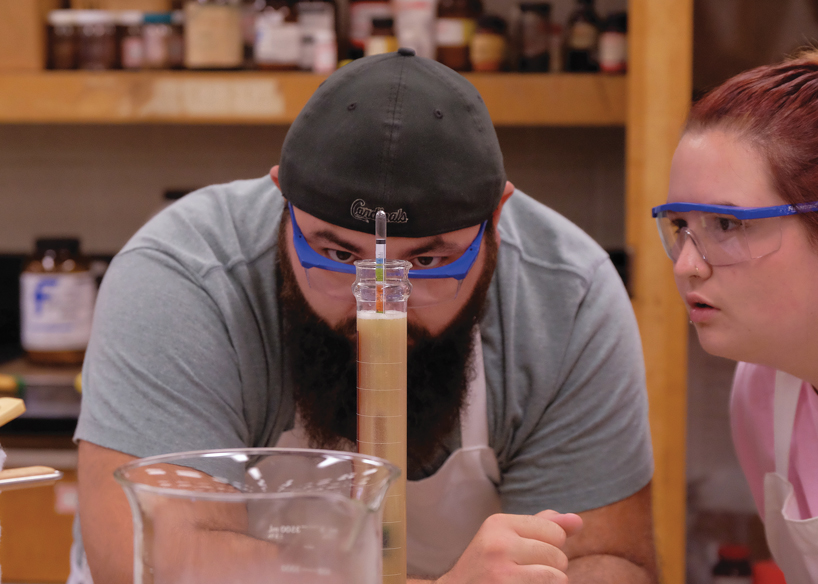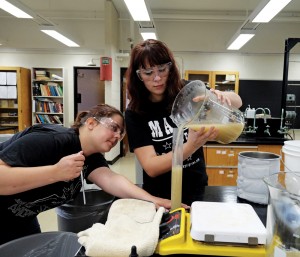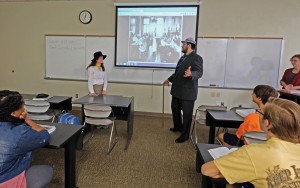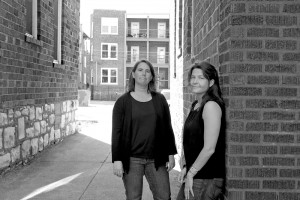
Brandon Garrison, a senior majoring in biology, and Taylor Obst, a junior majoring in business administration, use a hydrometer to measure specific gravity of the wort and determine the sugar content of a batch of beer they’re brewing for the UMSL course Beer Brewing: Chemical and Biochemical Principles. (Photos by August Jennewein)
With safety goggles protecting their eyes and lab books in hand, Brandon Garrison and Taylor Obst patiently monitor a glass cylinder of water as it warms on a heating plate. When the water reaches the right temperature, Garrison dumps a container of milled barley into the cylinder and begins mashing in. That’s what first sets this chemistry course apart from others offered at the University of Missouri–St. Louis.
Garrison and Obst are brewing beer. For credit.
“I needed a science class for my major,” says Obst, a junior majoring in business administration. “I like chemistry, and I like beer. So why not take a class that combines the two?”
“I’ve always appreciated beer,” says Garrison, a senior majoring in biology. “It’s interesting to see what goes into making each style.”
With a smile, he adds, “Maybe I can figure out why I like it so much.”
Bruce Hamper, assistant teaching professor of chemistry, calls the course a “food science class” and enthusiastically says brewing is “chemistry in action.”

Student Tory Freeman looks on as classmate Chelsea Mowery pours wort, a sweet liquid made from milled barley and water, into a graduated cylinder. They’re taking a UMSL course that teaches chemistry through beer brewing.
“We measure alcohol content, carbohydrates, bitterness, carbonation and other parameters of the beer that impact flavor and quality,” Hamper says. “Students are likely to remember these experiences long after the semester is over. How often can you say, ‘I brewed beer for class credit?’”
The class includes field trips to the quality testing labs at Anheuser-Busch’s St. Louis brewery and guest speakers like Marc Gottfried, brewmaster of the William K. Busch Brewing Co., maker of the Kräftig brand.
Students eventually brew a two-liter batch from start to finish. Obst and Garrison plan to brew an American stout, and they’ll be exploring the chemistry side of it all along the way.
A sneaky approach to learning
Some might call these courses offbeat or nontraditional. Ron Yasbin refers to them as “sneaky.” They’re also successful.
“These courses succeed because students choose them out of their interest and not because they have to take them,” says Yasbin, dean of the College of Arts and Sciences. “The courses are interesting to the students and are relevant in today’s culture. The fact that they carry ‘gen-ed’ or other required credits is a bonus.”
The college is home to numerous unusual courses. There’s Choice and Chance, which is basically a philosophy class on logic and probability that covers required, basic college-level math credits. And there’s Chemistry of Art, a museum studies course.
Further examples include Ghosts, Goblins and Godzillas; and Zombies, Vampires and Monsters taught through the Department of Anthropology and Archaeology.
“We investigate why some mythic narratives, like zombies, are so salient in our dominant culture,” Jennifer Nolan, assistant teaching professor of anthropology says of the latter. “In the process, students learn storytelling and communication skills and develop cultural and historical awareness.”

UMSL students Mary Gibbons and Nikolaus C. Martinez act as historic figures to better learn about people from the past in the UMSL course Reacting to the Past.
Taught by four faculty members across the history, English and foreign languages disciplines, the popular Reacting to the Past course involves students role-playing as people from bygone eras. In taking on those historic personas, they debate and defend various issues of the characters’ time, which gives the students a better understanding of how people throughout history lived and thought.
Teaching St. Louis through a show about Baltimore
UMSL has offered multiple courses centered on the HBO drama “The Wire.” And with good reason.
“The central character of ‘The Wire,’ so to speak, is Baltimore,” says Benjamin Torbert, associate professor of English at UMSL. “To study Baltimore is to study St. Louis.”
Torbert, who taught Pierre Laclede Honors College and graduate-level English courses centered on the show, points out that Baltimore and St. Louis share a loss of manufacturing, a sizeable drug trade, a preservation of pre-war housing stock and an independence from the surrounding counties.
“The Wire” examines Baltimore holistically with each of its five seasons adding an additional layer to the storytelling through the different perspectives of the metropolitan police department, justice system, drug trade, dockworker union, city politics, public schools and the news media.

Baltimore natives and UMSL criminologists Elaine Doherty (left) and Lee Slocum use the HBO program “The Wire” to teach a course on crime, justice and urban life. The show is based in Baltimore, which is similar in many ways to St. Louis.
UMSL criminologists Lee Slocum and Elaine Doherty both hail from Baltimore. They believed the show would be the perfect conduit for teaching a course on crime, justice and urban life.
“‘The Wire’ has been critically acclaimed as a unique show that very poignantly exposes the many issues of urban life,”
Doherty says. “Thus, it is not a crime show – it is a show that brings to light the challenges of housing, education, drugs and crime, public health, politics and the criminal justice system.”
Slocum and Doherty decided to collaborate on the course, which is offered each spring, because they felt their combined areas of expertise – community-police interactions and urban neighborhoods for Slocum, public health interventions and overlap of substance abuse and crime for Doherty – fit harmoniously with the themes from the show.
“The Wire” courses have also proven popular, which doesn’t surprise Yasbin, College of Arts and Sciences dean.
“Traditional college courses will always have a place at UMSL,” he says. “But our faculty continue to find new and creative ways to capture our students interest while ensuring they learn the material.”
This story was originally published in the fall 2015 issue of UMSL Magazine.















